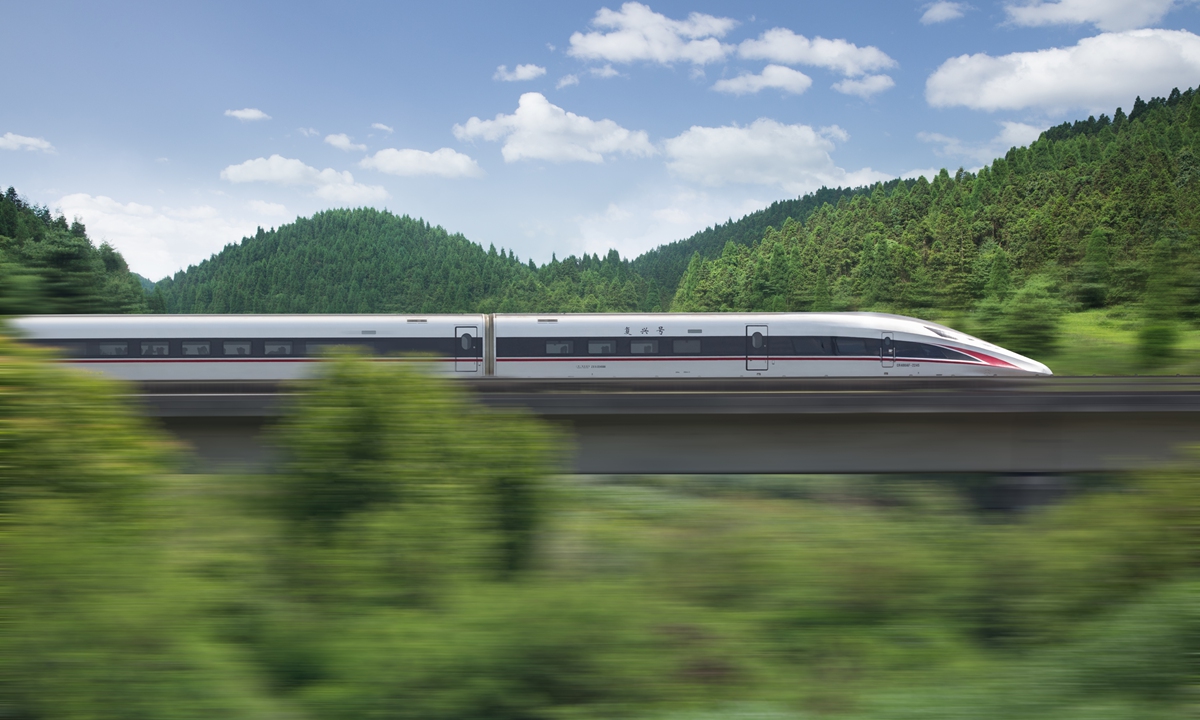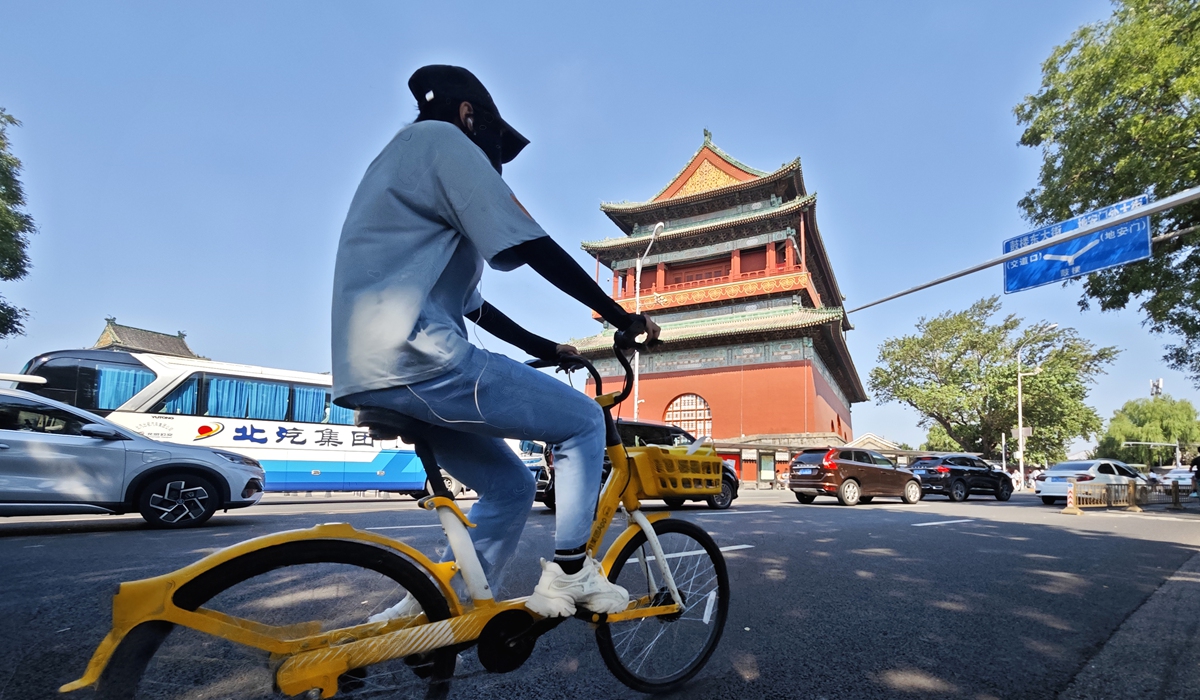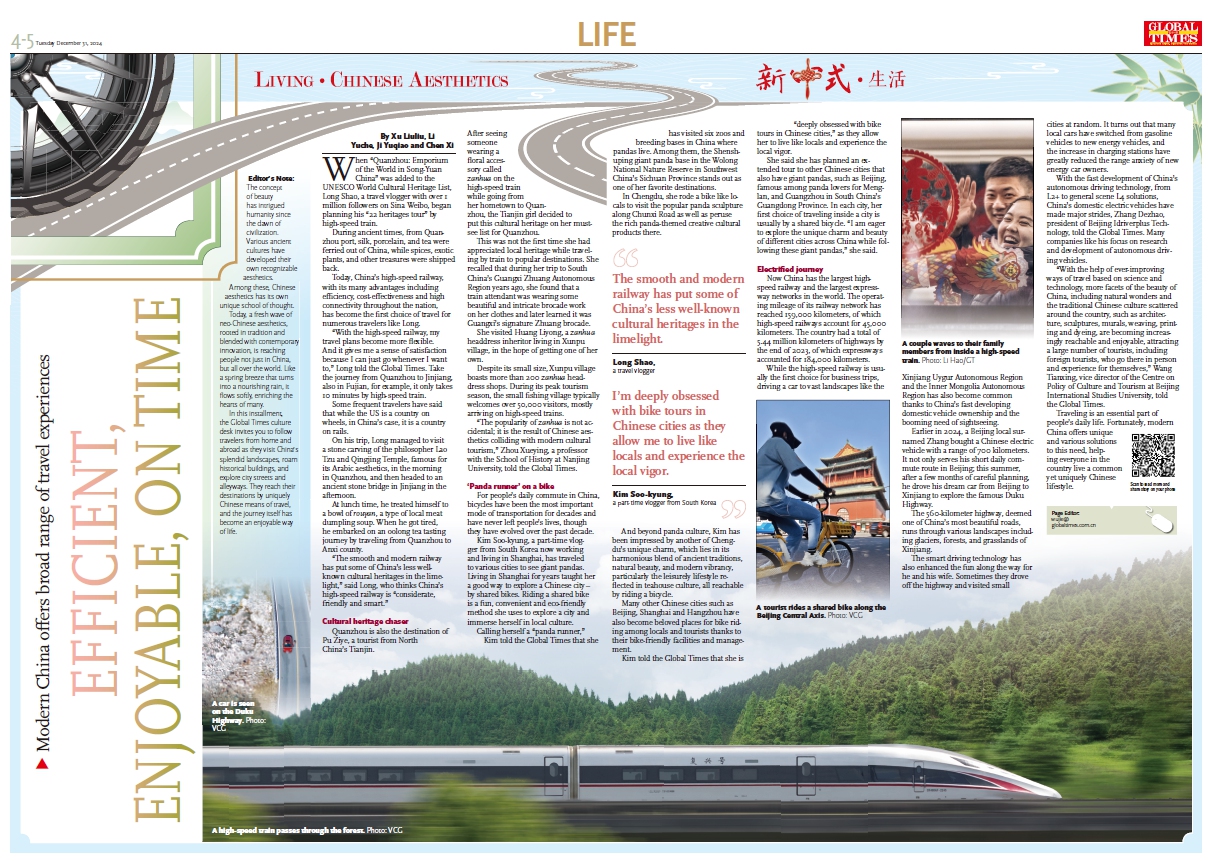ARTS / CULTURE & LEISURE
Modern China offers broad range of travel experiences
Efficient, enjoyable, on time

A high-speed train passes through a forest. Photo: VCG
When "Quanzhou: Emporium of the World in Song-Yuan China" was added to the UNESCO World Cultural Heritage List, Long Shao, a travel vlogger with over 1 million followers on Sina Weibo, began planning his "22 heritages tour" by high-speed train.
During ancient times, from Quanzhou port, silk, porcelain, and tea were ferried out of China, while spices, exotic plants, and other treasures were shipped back.
Today, China's high-speed railway, with its many advantages including efficiency, cost-effectiveness and high connectivity throughout the nation, has become the first choice of travel for numerous travelers like Long.
"With the high-speed railway, my travel plans become more flexible. And it gives me a sense of satisfaction because I can just go whenever I want to," Long told the Global Times. Take the journey from Quanzhou to Jinjiang, also in Fujian, for example, it only takes 10 minutes by high-speed train.
Some frequent travelers have said that while the US is a country on wheels, in China's case, it is a country on rails.
On his trip, Long managed to visit a stone carving of the philosopher Lao Tzu and Qingjing Temple, famous for its Arabic aesthetics, in the morning in Quanzhou, and then headed to an ancient stone bridge in Jinjiang in the afternoon.
At lunch time, he treated himself to a bowl of rouyan, a type of local meat dumpling soup. When he got tired, he embarked on an oolong tea tasting journey by traveling from Quanzhou to Anxi county.
"The smooth and modern railway has put some of China's less well-known cultural heritages in the limelight," said Long, who thinks China's high-speed railway is "considerate, friendly and smart."
Cultural heritage chaser
Quanzhou is also the destination of Pu Ziye, a tourist from North China's Tianjin. After seeing someone wearing a floral accessory called zanhua on the high-speed train while going from her hometown to Quanzhou, the Tianjin girl decided to put this cultural heritage on her must-see list for Quanzhou.
This was not the first time she had appreciated local heritage while traveling by train to popular destinations. She recalled that during her trip to South China's Guangxi Zhuang Autonomous Region years ago, she found that a train attendant was wearing some beautiful and intricate brocade work on her clothes and later learned it was Guangxi's signature Zhuang brocade.
She visited Huang Liyong, a zanhua headdress inheritor living in Xunpu village, in the hope of getting one of her own.
Despite its small size, Xunpu village boasts more than 200 zanhua headdress shops. During its peak tourism season, the small fishing village typically welcomes over 50,000 visitors, mostly arriving on high-speed trains.
"The popularity of zanhua is not accidental; it is the result of Chinese aesthetics colliding with modern cultural tourism," Zhou Xueying, a professor with the School of History at Nanjing University, told the Global Times.

A tourist rides a shared bike along the Beijing Central Axis. Photo: VCG
'Panda runner' on a bike
For people's daily commute in China, bicycles have been the most important mode of transportation for decades and have never left people's lives, though they have evolved over the past decade.
Kim Soo-kyung, a part-time vlogger from South Korea now working and living in Shanghai, has traveled to various cities to see giant pandas. Living in Shanghai for years taught her a good way to explore a Chinese city - by shared bikes. Riding a shared bike is a fun, convenient and eco-friendly method she uses to explore a city and immerse herself in local culture.
Calling herself a "panda runner," Kim told the Global Times that she has visited six zoos and breeding bases in China where pandas live. Among them, the Shenshuping giant panda base in the Wolong National Nature Reserve in Southwest China's Sichuan Province stands out as one of her favorite destinations.
In Chengdu, she rode a bike like locals to visit the popular panda sculpture along Chunxi Road as well as peruse the rich panda-themed creative cultural products there.
And beyond panda culture, Kim has been impressed by another of Chengdu's unique charm, which lies in its harmonious blend of ancient traditions, natural beauty, and modern vibrancy, particularly the leisurely lifestyle reflected in teahouse culture, all reachable by riding a bicycle.
Many other Chinese cities such as Beijing, Shanghai and Hangzhou have also become beloved places for bike riding among locals and tourists thanks to their bike-friendly facilities and management.
Kim told the Global Times that she is "deeply obsessed with bike tours in Chinese cities," as they allow her to live like locals and experience the local vigor.
She said she has planned an extended tour to other Chinese cities that also have giant pandas, such as Beijing, famous among panda lovers for Menglan, and Guangzhou in South China's Guangdong Province. In each city, her first choice of traveling inside a city is usually by a shared bicycle. "I am eager to explore the unique charm and beauty of different cities across China while following these giant pandas," she said.

A car is seen on the Duku Highway. Photo: VCG
Electrified journey
Now China has the largest high-speed railway and the largest expressway networks in the world. The operating mileage of its railway network has reached 159,000 kilometers, of which high-speed railways account for 45,000 kilometers. The country had a total of 5.44 million kilometers of roads by the end of 2023, of which expressways accounted for 184,000 kilometers.
While the high-speed railway is usually the first choice for business trips, driving a car to vast landscapes like the Xinjiang Uygur Autonomous Region and the Inner Mongolia Autonomous Region has also become common thanks to China's fast developing domestic vehicle ownership and the need for sightseeing.
Earlier in 2024, a Beijing local surnamed Zhang bought a Chinese electric vehicle with a range of 700 kilometers. It not only serves his short daily commute route in Beijing; this summer, after a few months of careful planning, he drove his dream car from Beijing to Xinjiang to explore the famous Duku Highway.
The 560-kilometer highway, deemed one of China's most beautiful roads, runs through various landscapes including glaciers, forests, and grasslands of Xinjiang.
The smart driving technology has also enhanced the fun along the way for he and his wife. Sometimes they drove off the highway and visited small cities at random. It turns out that many local cars have switched from gasoline vehicles to new energy vehicles, and the increase in charging stations have greatly reduced the range anxiety of new energy car owners.
With the fast development of China's autonomous driving technology, from L2+ to general scene L4 solutions, China's domestic electric vehicles have made major strides, Zhang Dezhao, president of Beijing Idriverplus Technology, told the Global Times. Many companies like his focus on research and development of autonomous driving vehicles.
"With the help of ever-improving ways of travel based on science and technology, more facets of the beauty of China, including natural wonders and the traditional Chinese culture scattered around the country, such as architecture, sculptures, murals, weaving, printing and dyeing, are becoming increasingly reachable and enjoyable, attracting a large number of tourists, including foreign tourists, who go there in person and experience for themselves," Wang Tianxing, vice director of the Centre on Policy of Culture and Tourism at Beijing International Studies University, told the Global Times.
Traveling is an essential part of people's daily life. Fortunately, modern China offers unique and various solutions to this need, helping everyone in the country live a common yet uniquely Chinese lifestyle.

Modern China offers broad range of travel experiences.






